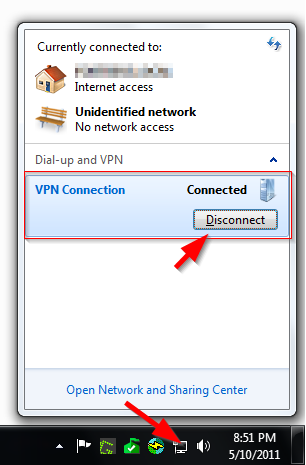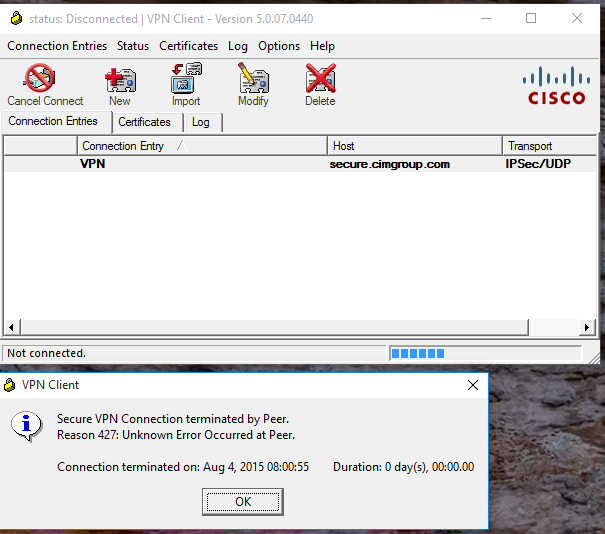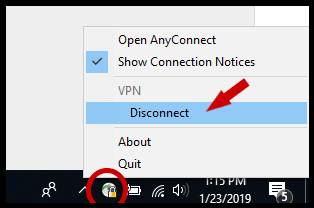- Cisco Vpn Client Windows 10 Fix
- Cisco Vpn Client Windows 10 Error 442
- Cisco Vpn Client Windows 10 Free Download
- Cisco Vpn Client 5.0.07.0440 Download
Is there any way to install a particular Cisco VPN protocol (eg. DTLS) in Windows 10's native VPN client (as shown in the screenshot)? I found apps for other protocols (Eg. Pulse Connect) in the Microsoft Store which integrate into the Windows VPN interface, but none for Cisco.
- Alternate to Cisco Client VPN for Windows 10 Posted by Administrator If you are looking for an alternate software for Cisco Client VPN software, here is the step by step guide to set it up.This worked for me in Windows 10 Pro 64 bit edition computer.
- Cisco Vpn Client For Windows 10 free download, and many more programs.
Cisco Vpn Client Windows 10 Fix
If you have upgraded from Windows 7/8 and need to install the Cisco VPN client then you can use the following instructions on how to cleanly install it or fix a bad install of it after upgrading to Windows 10.
7 Steps total

Step 1: Uninstall Cisco VPN Client if it was already installed
Uninstall Cisco VPN client from the PC. (If you get and error trying to uninstall, you may need to install DNE updater ftp://files.citrix.com/dneupdate64.msi first)
Step 2: Uninstall DNE updater software
Uninstall any DNE updater software that may be installed. After uninstalling run a registry clean (you can use CCleaner if you like). Then reboot your PC.
Step 3: Run Winfix.exe
After reboot run Winfix.exe from here. ftp://files.citrix.com/winfix.exe
After you run the cleanup reboot your PC again.

Step 4: Install Sonicwall VPN client
SonicWall VPN is will install the DNE service that will work with Windows 10. Install the SonicWALL VPN found here. http://www.gleescape.com/wp-content/uploads/2014/09/sonic64.zip and then reboot your PC.
(You do not need to launch the SonicWALL client, merely installing the client will install the proper DNE services)
Step 5: Reinstall/Install Cisco VPN client version 5.0.0.74

Download latest Cisco VPN client from Cisco or from here http://www.gleescape.com/wp-content/uploads/2014/09/vpn64bit.zip
Extract the zip file to a temp location (uncheck run exe after extraction).
Navigate to the temp folder and run the MSI installer (not the exe) to install the VPN client. Reboot the PC
Step 6: Apply Registry fix.
•Open regedit
•Browse to the registry key HKLMSYSTEMCurrentControlSetServicesCVirtA
•Select the display name to modify:
•x64 - '@oem8.ifn,%CVirtA_Desc%;Cisco Systems VPN Adapter for 64-bit Windows' to 'Cisco Systems VPN Adapter for 64-bit Windows'
Reboot your PC.
Step 7: Launch Cisco VPN client to ensure that it lauches.
After you verify that the VPN client launches you can then uninstall the SonicWALL VPN client and you should be able to once again use the Cisco VPN client.
Cisco Vpn Client Windows 10 Error 442
References
- Fix found at Gleescape
0 Comments
Overview
Stanford's VPN allows you to connect to Stanford's network as if you were on campus, making access to restricted services possible. To connect to the VPN from your Windows computer you need to install the Cisco AnyConnect VPN client.
Two types of VPN are available:
- Default Stanford (split-tunnel). When using Stanford's VPN from home, we generally recommend using the Default Stanford split-tunnel VPN. This routes and encrypts all traffic going to Stanford sites and systems through the Stanford network as if you were on campus. All non-Stanford traffic proceeds to its destination directly.
- Full Traffic (non-split-tunnel). This encrypts all internet traffic from your computer but may inadvertently block you from using resources on your local network, such as a networked printer at home. If you are traveling or using wi-fi in an untrusted location like a coffee shop or hotel, you may wish to encrypt all of your internet traffic through the Full Traffic non-split-tunnel VPN to provide an additional layer of security.
You can select the type of VPN you want to use each time you connect to the Stanford Public VPN.
Install the VPN client
- Download the Cisco AnyConnect VPN for Windows installer.
- Double-click the InstallAnyConnect.exe file.
- When a message saying the Cisco AnyConnect client has been installed, click OK.

Connect to the Stanford VPN
- Launch the Cisco AnyConnect Secure Mobility Client client.
If you don't see Cisco AnyConnect Secure Mobility Client in the list of programs, navigate to Cisco > Cisco AnyConnect Secure Mobility Client. - When prompted for a VPN, enter su-vpn.stanford.edu and then click Connect.
- Enter the following information and then click OK:
- Group: select Default Stanford split- tunnel (non-Stanford traffic flows normally on an unencrypted internet connection) or Full Traffic non-split-tunnel (all internet traffic flows through the VPN connection)
- Username: your SUNet ID
- Password: your SUNet ID password
- Next, the prompt for two-step authentication displays. Enter a passcode or enter the number that corresponds to another option(in this example, enter 1 to authenticate using Duo Push to an iPad). Then click Continue.
- You may have to scroll down the list to see all of your options.
- If your only registered authentication method is printed list, hardware token, or Google Authenticator, the menu does not display. Enter a passcode in the Answer field and click Continue.
- Click Accept to connect to the Stanford Public VPN service.
- Once the VPN connection is established, a message displays in the lower-right corner of your screen, informing you that you are now connected to the VPN.
Cisco Vpn Client Windows 10 Free Download
Disconnect from the Stanford VPN
Cisco Vpn Client 5.0.07.0440 Download
- In the notification area, click the Cisco AnyConnect icon if it is displayed. Otherwise, go to your list of programs and click Cisco AnyConnect Secure Mobility Client.
- At the prompt, click Disconnect.
